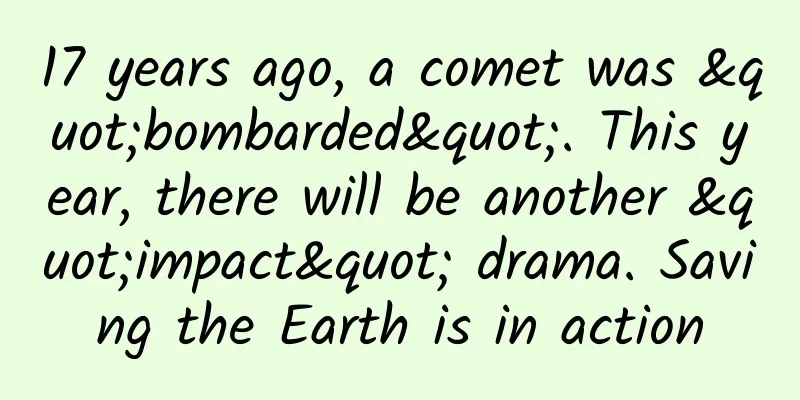17 years ago, a comet was "bombarded". This year, there will be another "impact" drama. Saving the Earth is in action

|
Let me correct one thing first. The so-called "bombardment" is an adjective used by the media. The correct term is collision. The shell that hit was called "Deep Impact"/ At 13:52 Beijing time on July 4, 2005, a drama of "bombarding" a comet was staged 130 million kilometers away from the earth. Many netizens may not know about this drama, but it caused a great response in the scientific community, especially in the astrophysics community. You know, this is the first time that humans have extended the "war" to an asteroid. The target asteroid is the nucleus of a comet called Stamp 1, which is about 14 kilometers long and 5 kilometers wide. The projectile that bombarded the comet is called Deep Impact, a probe that NASA (National Aeronautics and Space Administration) began planning in 1999 and launched on January 13, 2005 after more than five years of research and development at a cost of $330 million. After more than five months of tracking, the Deep Impact spacecraft traveled 430 million kilometers to approach the "target". After observing and taking pictures of a large amount of data and transmitting it back, it slammed into the comet's nucleus at a relative speed of 10.2 kilometers per second, ten times faster than a cannonball, completing the great mission of mankind's "first impact". The impact was carried out by an impactor released by the probe on July 4 when it was 50 kilometers away from Stamp 1. The impactor was made of copper and aluminum, had a mass of 370 kilograms, and an impact energy equivalent to 4.7 tons of TNT. The whole process took only 3.7 seconds. The probe enjoyed the space fireworks produced by the impact, but because the smoke and dust caused by the collision obscured the impact point, the situation after the impact could not be seen clearly. Coincidentally, the Rosetta comet probe launched by the European Space Agency was also nearby, 80 million kilometers away from the collision site. After a week of observation and filming, it sent back a large amount of data on the changes in the clouds after Temple 1 was hit. By studying these data, astronomers concluded that the impact created a large pit with a radius of about 30 meters on the surface of the comet. More than 5,000 tons of dust were thrown away from the nucleus at a speed of 110 to 300 meters per second. About 5,000 tons of ice and about 15 tons of hydrogen cyanide were thrown into space in the form of ice particles, which quickly sublimated into gas under solar radiation. In the end, NASA announced that an impact crater as large as a football field and 30 to 50 meters deep was left on the comet nucleus, but the impact only caused the comet's speed to change by 0.0001 mm per second, and the comet's future perihelion will be reduced by 10 meters. As a result, this impact test achieved the following results: First, for the first time, mankind saw what a comet nucleus looked like and analyzed the material composition of the comet nucleus, which was of great help in further exploring and understanding the birth of the solar system, the origin of water and life on Earth, etc.; secondly, the remote unmanned control technology of the probe was perfect, and the precise impact of threading a needle thousands of miles away was shocking, and it accumulated valuable experience for future human beings' more in-depth space exploration. You know, if there is a slight deviation, the impactor may miss the target and hundreds of millions of dollars will be wasted. So what is the fundamental purpose of this impact besides the above results? It is mainly to deal with the threat of asteroids, because this threat has destroyed 80% of the species on Earth. Scientists have always wanted to find a way to avoid it by studying asteroids. Why would an asteroid hitting the Earth cause a huge disaster? Many netizens always underestimate the power of an asteroid impact, thinking that it is just some space debris hitting the earth, or a volcanic eruption, how could it cause a devastating disaster for mankind? A train collision is just that, how could an asteroid of more than ten or twenty meters in size cause the huge power of the Tunguska explosion and the Chelyabinsk region? This is a lack of understanding of the relationship between speed and energy. For objects of the same mass, the greater the speed, the greater the energy of the impact, and as the speed increases, the impact energy increases exponentially. A very simple example: if you take a wooden stick and gently touch your head or hit it quickly, will the consequences be the same? So how fast does an asteroid hit the Earth? Based on the orbital velocity and escape velocity around the Sun, the speed of an asteroid should generally be between 30 and 42 kilometers. As for the relative speed when it hits the Earth, it depends on the angle from which it hits. If it hits the Earth from the front of its orbit, its speed will be the speed of the asteroid itself plus the Earth's orbital speed, which is at least between 60 and 72 kilometers. If it hits from a different side or from the back, its speed will vary a lot. Therefore, the relative speed of asteroids hitting the Earth varies. Judging from the small celestial bodies that hit the Earth in the past, the speed is generally between 10 kilometers and 40 kilometers per second. According to some experts, the asteroid that destroyed the dinosaurs 6,500 years ago was about 10 kilometers in diameter and hit at a speed of about 30 kilometers per second; the asteroid that caused the Tunguska explosion was about 20 meters in diameter and hit at a speed of about 20 kilometers per second; the asteroid that hit the Chelyabinsk region was about 17 meters in diameter and hit at a speed of about 19 kilometers per second. Assuming that these asteroids are rocky asteroids, based on the granite density of 2.7 tons per cubic meter, the spherical volume formula shows that their masses are approximately: an asteroid with a diameter of 10 kilometers has a mass of 1.4 trillion tons, an asteroid with a diameter of 20 meters has a mass of 11,310 tons, and an asteroid with a diameter of 17 meters has a mass of 6,173 tons. Of course, very small asteroids are not perfect spheres, but more often irregular shapes such as potato shapes, so the calculations here are for reference only. The impact energy formula is E=1/2mv^2, where E represents energy, m represents the mass of the impacting object, and v represents the impact velocity. Based on this formula, let's simply calculate how much energy these asteroid impacts have. 65 million years ago, the asteroid that caused the extinction of about 80% of species including the dinosaurs had an impact energy equivalent to 150 trillion tons of TNT. According to some information, scientists have calculated that the impact energy is about 120 trillion tons of TNT equivalent, which means that the density or speed values used in their calculations are slightly different from mine. The energy of the asteroid that caused the Tunguska explosion was about the energy of 540,000 tons of TNT, and the energy of the asteroid that hit the Chelyabinsk region was about the energy of 266,000 tons of TNT. Of course, these asteroids may not all be rocky, and some may be icy comets, so although the impact energy will be reduced, the destructive power is still huge. Many experts believe that the Tunguska explosion was probably caused by a comet of more than 20 meters in diameter, which exploded and evaporated in the air before reaching the ground. Even so, its energy reached the equivalent of more than 200,000 tons of TNT, and the shock wave of the air explosion was even more powerful, thus destroying thousands of square kilometers of trees. Some experts believe that the actual explosion energy of the asteroid that hit the Chelyabinsk area reached 450,000 tons of TNT equivalent, which is equivalent to the power of 30 Hiroshima atomic bombs exploding simultaneously, which caused the shock wave to affect thousands of square kilometers, more than 7,000 houses were damaged, glass was shattered, and 1,500 people were injured. This is why an asteroid impact can be so devastating. Probability of asteroid impact and preventive measures/ There are countless asteroids flying in the solar system. Since asteroids are very small, they cannot be seen from far away, so most of them cannot be seen. Only some that are relatively close can be discovered. There are more than 1.2 million confirmed asteroids, of which 57% have been officially numbered. There are hundreds of asteroids larger than 4 kilometers, and more than 2,000 larger than 1 kilometer. Among these asteroids, the most threatening to humans are near-Earth asteroids, which are asteroids whose orbits intersect with the Earth's orbit. More than 25,000 such asteroids have been discovered, of which more than 2,200 pose a potential threat to the Earth. There are more than 500 near-Earth asteroids larger than 1 kilometer in diameter, and any one of them would bring a devastating disaster if it hits the Earth. What is the probability of these asteroids hitting the Earth? Through scientific modeling, astronomers have obtained the following data: the probability of an asteroid with a diameter greater than 1 km hitting the Earth is once every 100,000 years; the probability of a small celestial body with a diameter of 10 meters hitting the Earth is once every 3,000 years. Many scientists believe that the risk of asteroid impacts has been seriously underestimated. In fact, we have also seen that asteroids with a diameter of 10 meters have occurred many times in the past century. According to data collected by sensors released by NASA, there have been thousands of fireball events (asteroid fragments hitting the atmosphere and burning up) around the world since 1988. It has been 65 million years since an asteroid larger than 1 km hit the Earth, so the probability of being hit by such a large asteroid is increasing. As early as the last century, the scientific community began to attach great importance to the prevention of asteroid impacts. The first to propose this topic were professors at the Massachusetts Institute of Technology, who provided this issue as a topic for students in the classroom. In 2008, the United Nations established an organization for early warning and monitoring of asteroids, called the Federation of Space Explorers; in 2013, the International Asteroid Warning Team was formally established to specifically deal with asteroid hazards. Although it is just a small group, it is composed of scientists, observatories and space agencies from all over the world, and the forces it can mobilize are huge. But for decades, the prevention of asteroids has remained at the level of monitoring, and sometimes it is even impossible to prevent. For example, on July 25, 2019, an asteroid later named 2019 OK passed by the Earth. It was not discovered until an hour before it passed by the Earth. The size of this asteroid is 57 meters by 130 meters. If it hits the Earth, it will destroy a state! Therefore, monitoring needs to be greatly strengthened, and the earlier the discovery, the greater the preventive effect. But how to avoid the devastating impact 6,500 years ago so that humans can continue for a longer time? Scientists have conceived many ways, such as kinetic impact, gravitational drag, nuclear bomb explosion, etc., the purpose is to make asteroids deviate from their orbits and avoid hitting the earth. Unfortunately, a practical method has not been found so far, because there is no way to verify this theory on Earth, and a real asteroid must be found to test it. The scientific community has been making unremitting efforts, and NASA is still at the forefront. The "bombardment" comet experiment 17 years ago was an attempt. In September of this year, NASA will once again stage an impact drama. This time the target of the impact is a binary asteroid system called "Dithymus", and the impact "cannon" has already been launched. How this year's asteroid impact drama will unfold This drama has already begun in 2021. At 14:20 Beijing time on November 24, a spacecraft named "DART" was successfully launched from the Vandenberg Base in the United States and flew towards a binary asteroid system called "Ditimos". The size of this spacecraft is 1.8*1.9*2.6 meters, and the launch mass is 610 kilograms. This mission is called the "Double Asteroid Redirection Test" and the protagonist is the "DART" spacecraft, which has only one mission, which is to catch up with "Ditimos" and then crash into the smaller asteroid, dying in the line of duty to obtain a series of data. It is another AI dedicated to enabling humans to live longer, and "DART" should have a place in the future martyrs' shrine of mankind. The main star of the "Didimos" binary asteroid is called Didymos, with an average diameter of about 780 meters and a rotation period of 2.26 hours; the secondary star is called Dimorphos, with a diameter of about 160 meters and a rotation period of 11.9 hours around the main star. The two stars are about 1 kilometer apart. The orbit of this asteroid will not pose any threat to the Earth in the foreseeable future, but the perigee distance is not too far, so it is just right for impact tests. The mission of DART is to hit the secondary star, with a mass of 550 kg remaining at a speed of 6.6 km/h, and an impact energy of 5.7 tons of TNT equivalent. This impact is considered to be the first attempt in human history to challenge the deflection of an asteroid orbit. Scientists describe this impact as a bit like using a golf cart to hit a football field full of stones. The impact is expected to form a 10-meter impact crater on the asteroid's surface, change its orbital speed by about 1%, and shorten its period by about 10 minutes, causing the binary asteroid to change its orbit as a whole and achieve "redirection". The 2005 impact formed a 30-meter radius crater on the comet, while this impact can only form a 10-meter diameter crater, indicating that the density of this asteroid is much greater than that of the comet. By observing and calculating the impact effects, we will get a lot of valuable data. By analyzing these data, we can know how much force is needed to deflect the orbit of asteroids when they are heading towards us in the future, so that the Earth can escape the disaster. This may be the most direct and effective way to solve the threat of asteroid impacts. If it succeeds, it will be a great blessing for mankind. This plan was first planned as early as 10 years ago in 2012. It was originally planned to be completed by NASA and ESA in cooperation. NASA would be responsible for the impact and ESA would be responsible for detection and observation. A probe would be sent to the vicinity of Didymos to study the physical properties, geological composition, internal structure of the asteroid surface, and then observe the situation after the impact to obtain a more accurate comparison before and after. However, the mission was difficult and there were financial difficulties. ESA could not continue the mission and stopped it halfway. However, ESA later picked up the plan and designed a smaller probe called "Hera", which is expected to be launched in 2026 to track "Ditimos" and assess the impact of DART's collision. In order to better observe the impact process and results, the DART spacecraft carries a small cubic satellite called "LICIA", which will be released 10 days before the impact. The satellite is provided by Italy and is equipped with two cameras, one of which is a high-resolution black-and-white camera called "LEIA", which can take high-definition black-and-white images of the asteroid surface during the impact, allowing scientists to view and analyze the resulting plumes and debris; the other camera is called "LUKE", which can capture color spectral images to make the asteroid's terrain clearer. Now, Didymos is flying towards the Earth and will be closest to the Earth between September 26 and October 1 this year, when it will be less than 11 million kilometers away from the Earth. DART will rendezvous with it and choose the right time to complete the self-sacrificing collision. The LICIA satellite will transmit the impact live to the Earth, and the electrical signal transmission at the speed of light takes more than 30 seconds; in addition, telescopes deployed on the Earth's surface and in space will also be aimed at this group of asteroids for observation. It is reported that this collision drama will be broadcast live to the world. Will we be lucky enough to see this space wonder created by humans? Let's wait and see. Friends who are interested can lock in the time period from September 26 to October 1. Will you watch it? Welcome to discuss, thank you for reading. The copyright of Space-Time Communication is original. Please do not infringe or plagiarize. Thank you for your understanding and cooperation. |
<<: This "smallest organ in the human body" cannot be ignored when injured!
Recommend
3 questions to ask new media public accounts to increase followers through content!
Speaking of increasing followers on public accoun...
In the second half of knowledge payment, who will be the future: JD.com, Tmall or Amazon?
Ever since Luo Zhenyu gave his first lecture titl...
Three pieces of silk fabrics recreate the shock of the Silk Road!
Spanning 5,000 years, more than 210 pieces/sets o...
Popular Science Illustrations | Smart agriculture is growing rapidly, stepping into the future farm
...
Revealed: Why is the thickness of the rocket shell only a few millimeters?
Seeing the Long March 5, a behemoth that is tens ...
The Autumnal Equinox is here. Do a good job of "four preventions" and "three no leaks" to have a good autumn.
The Autumnal Equinox has arrived, indicating that...
Can ginger cure colds and relieve dysmenorrhea? You will never guess the benefits of ginger
Whenever the season of colds is more common, peop...
Skyworth's financial report shows that the color TV industry is difficult to grow
The 2013 financial year performance report releas...
A new landmark in Antarctica! Qinling Station has a “Chinese style”
On February 7, General Secretary Xi Jinping sent ...
A short video account with precise vertical content and followers. A simple operation in a niche field can earn you over 10,000 yuan a month
There are several main ways to monetize a zodiac ...
The realm of "stealing skills": creating oneself from classics | Yihai Shizhen
How did the talented painter Lippi learn from oth...
How to make a good online event promotion plan?
In marketing psychology, herd mentality, greed fo...
More accurate than the sun! What kind of clock can be accurate to just one second in 35 million years?
Measuring time accurately is far more important t...
After one year online and six months of operation, what did Douyin do to defeat Kuaishou?
First of all, the most important point is: I am a...
How does "Laso" reveal the super-powerful side of the Milky Way?
Editor's note: General Secretary Xi Jinping p...









